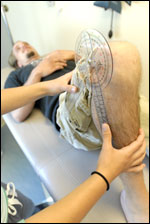CDC Features
Care at Comprehensive Treatment Centers Can Save Lives

Comprehensive treatment centers are specialized healthcare centers that bring together a team of doctors, nurses, and other health professionals experienced in treating people with rare or complex chronic medical conditions.1
CDC's Division of Blood Disorders, along with other federal agencies, supports a network of 135 comprehensive treatment centers able to meet the unique challenges of people with hemophilia. Hemophilia is an inherited blood disorder that can lead to chronic health problems such as joint disease over time. However, if the disorder is managed properly, people with hemophilia can live long, healthy lives.

A CDC study of 3,000 people with hemophilia showed that those who used a hemophilia treatment center were 40% less likely to die of a hemophilia-related complication compared to those who did not receive care at a treatment center.2 Similarly, people who used a treatment center were 40% less likely to be hospitalized for bleeding complications.3
The Model
Each hemophilia treatment center provides access to multidisciplinary health care professionals:
• Hematologists (doctors who specialize in blood)
• Orthopedists (doctors who specialize in bones, joints, and muscles)
• Physical therapists
• Nurses
• Social workers and other mental health professionals
Comprehensive hemophilia treatment centers emphasize prevention services to help reduce or eliminate complications. These services include using preventive medicine and connecting patients with community groups that provide education and support to families. For example, the National Hemophilia Foundation partners with hemophilia comprehensive treatment centers and CDC to educate people with this disorder about the top five things they can do to reduce complications. (For more information about how to help prevent complications, visit www.hemophilia.org*.
Advancing Research and Ensuring Safety
One of the major challenges facing researchers and scientists who work on rare disorders such as hemophilia is lack of access to uniform data. Hemophilia treatment centers can participate in CDC's Universal Data Collection (UDC) program, which collects a consistent set of data to monitor the health of people with hemophilia. The data are used to advance research for this condition and other related disorders.
Another important aspect of the UDC program is ensuring that blood products used by people with hemophilia do not contain known viruses. Participants in the UDC program give a blood sample each year during their annual clinic visit. A portion of this sample is tested for certain viruses. This testing can be an early indication if certain harmful viruses are being transmitted through the Nation's blood products. Today, blood products in the U.S. blood supply are considered safe from known viruses. However, continued testing through the UDC program can help to ensure safety – both for the hemophilia community and others using blood products.4
CDC also supports treatment and research center networks for other bleeding and clotting disorders. There are now six treatment centers for people with thalassemia and eight for people with thrombosis.5 In addition, CDC would like to conduct research to identify which factors make the comprehensive treatment center model a success. This information could be used to help treat and control other rare and complex medical conditions.
Additional Information and Resources:

Comprehensive Treatment Centers
Learn more about CDC's network of comprehensive treatment centers.

Hemophilia
Find information about hemophilia.

Universal Data Collection Project
CDC conducts research on hemophilia and other blood disorders through the Universal Data Collection project.

Blood Disorders
CDC's Division of Blood Disorders works to prevent and reduce complications from certain blood disorders.
References
1. Baker JR, Crudder SO, Riske B, Bias V, Forsberg A. A model for a regional system of care to promote the health and well-being of people with rare chronic genetic disorders. Am J Public Health 2005; 95:1910-1916. Return
2. Soucie JM, Nuss R, Evatt, B, Abdelhak A, Cowan L, Hill H, Kolakoski M, Wilber N, and the Hemophilia Surveillance System Project Investigators. Mortality among males with hemophilia: relations with source of medical care. Blood 2000; 96:437-442. Return
3. Soucie JM, Symons J, Evatt B, Brettler D, Huszti H, Linden J, and the Hemophilia Surveillance System Project Investigators. Home-based factor infusion therapy and hospitalization for bleeding complications among males with hemophilia. Haemophilia 2001; 7:198-206. Return
4. Blood Safety Monitoring Among Persons with Bleeding Disorders -- United States, May 1998--June 2002. MMWR 2003; 51:1152-1154. Return
5. Dowling NF, Beckman MG, Manco-Johnson M, et al. The U.S. thrombosis and hemostasis centers pilot program. J Thromb Thrombolysis 2007; 23:1-7. Return
Page last updated: November 26, 2007
Content source: Division of Blood Disorders, National Center for Birth Defects and Developmental Disabilities
Content owner: National Center for Health Marketing
URL for this page: www.cdc.gov/Features/ComprehensiveCare


